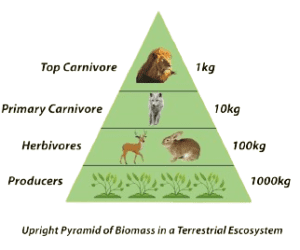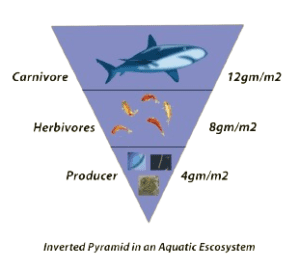Ecological Pyramids
A key to understanding the structure and function of ecosystems

Intended Learning Outcomes
At the end of this session, students will be able to
• Explain ecological pyramids
• Classify ecological pyramids
• Explain the consequences of ecological pyramids and ecosystem function
• Explain Bio-magnification
What are Ecological Pyramids?
• Ecological pyramids are graphical representations of the trophic structure of ecosystems.
• Trophic levels are the feeding position in a food chain such as primary producers, herbivores, primary carnivores, etc.
Types of ecological pyramid
Three types of ecological pyramids can usually be distinguished namely:
1. Pyramid of numbers
2. Pyramid of biomass
3. Pyramid of productivity
Pyramid of numbers
• Is the graphic representation of number of individuals per unit area of various trophic levels
• Large numbers of producers tend to form the base
• Lower numbers of top carnivores occupy the tip

Pyramid of numbers – example
• The shape of the pyramid of numbers vary from ecosystem to ecosystem.
• In aquatic ecosystems and grassland communities, autotrophs are present in large numbers per unit area.
• They support a lesser number of herbivores, which in turn support fewer carnivores.

‘Inverted’ + ‘spindle- shaped pyramids
Evaluating the pyramid of numbers
|
ADVANTAGES |
DISADVANTAGES |
|
Simple easy method (number counting) of giving an overview |
Numbers of a specific species can be too great to measure accurately |
|
Good for comparing changes to the ecosystem at different times of year e.g. between seasons |
Does not take into account ‘juveniles’ or immature forms |
|
|
All organisms are included regardless of size, hence ‘inverted’ pyramids |
Pyramid of biomass
• Is the graphic representation of biomass present per unit area of different trophic levels, with producers at the base and top carnivores at the tip.
• Biomass is calculated by the mass of each individual x number of individuals at each trophic level (g m-2 or g m-3)
The inverted pyramid of biomass
• In an aquatic habitat the pyramid of biomass is inverted or spindle shaped where the biomass of trophic level depends upon the reproductive potential and longevity of the member.
Evaluating a pyramid of biomass
|
ADVANTAGES |
DISADVANTAGES |
|
Overcomes the problems of pyramids of number |
Only uses samples from populations, so difficult to measure biomass exactly |
|
|
The time of year that biomass is measured influences result e.g. trees in summer |
|
|
Organisms of the same size do not necessarily have the same energy content |
|
|
Inverted’ pyramids may result from producers with a high turnover rate |
Pyramid of productivity
• The pyramid of productivity is a graphic representation of the flow of energy through each trophic level of a food chain over a fixed period. The input of solar energy may be indicated as an extra layer at the base.
• Only 10% of the energy is available to the next trophic level (as per Lindemann’s ten percent rule).
• The energy level of each trophic level has two arts i.e. Net Production (NP) and Respiration (R) and is measured in KJ m-2yr-1
Pyramid of productivity
|
Advantages |
Disadvantages |
|
No inverted pyramids are obtained
|
It is difficult and complex to collect energy data |
|
Shows the actual energy transferred and allows for rate of production |
The problem always exists in assigning a species to a specific trophic level, |
|
Can compare different ecosystems based on relative energy flows |
|
Consequences of ecological pyramids and ecosystem function
Bioaccumulation- when plants/animals take up a chemical from the environment and do not excrete it. The chemical builds up in the organism over time to a potentially lethal level.
Biomagnification- refers to the sequence of processes that results in higher concentrations of the chemical in organisms at higher levels in the food chain (at higher trophic levels). In this way, the chemical’s concentration is magnified from trophic level to trophic level. The concentration of the chemical may not affect lower levels of the food chain but the top levels take in so much it can cause disease or death.
• There are many pollutants like DDT that are not bio-degradable. These accumulate in the organisms and cause serious health problems. The contamination of water with these pollutants results in their entry into the microscopic plants and animals. These organisms are fed upon by higher aquatic life like the fish. The fish in turn are fed upon by the land animals including man.
• Thus, the pollutant reaches the body of man. At each step in the food chain, the contaminant increases in quantity. This is because a fish feeds on a large quantity of smaller plants and man eats fish. These contaminants like DDT remain in the fats and are not degraded in the body. Over the years the amount of DDT increases in the body. This is called bio-magnification.
Summary
• Ecological pyramids are graphical representations of the trophic structure of ecosystems
• Ecological Pyramids can be classified as
Pyramid of numbers
Pyramid of biomass
Pyramid of productivity
• Bio-accumulation – when plants / animals take up a chemical from the environment and do not excrete it
• Bio-magnification – refers to the sequence of processes that result in higher concentrations of the chemical in organisms at higher levels in the food chain
Also, Visit:
B. Pharma Notes | B. Pharma Notes | Study material Bachelor of Pharmacy pdf